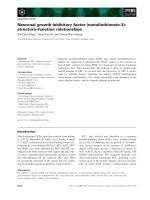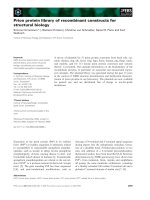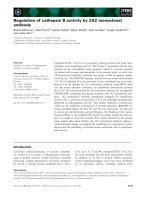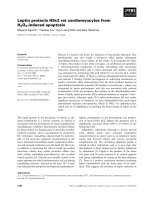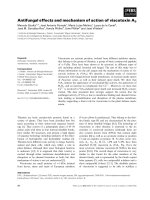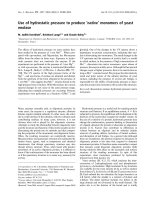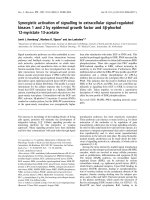Báo cáo khoa học: "Automatically generating annotator rationales to improve sentiment classification" docx
Bạn đang xem bản rút gọn của tài liệu. Xem và tải ngay bản đầy đủ của tài liệu tại đây (167.22 KB, 6 trang )
Proceedings of the ACL 2010 Conference Short Papers, pages 336–341,
Uppsala, Sweden, 11-16 July 2010.
c
2010 Association for Computational Linguistics
Automatically generating annotator rationales
to improve senti ment classificat ion
Ainur Yessenalina Yejin Choi Claire Cardie
Department of Computer Science, Cornell University, Ithaca NY, 14853 USA
{ainur, ychoi, cardie}@cs.cornell.edu
Abstract
One of the central challenges in senti ment-
based text categorization is that not ev-
ery portion of a document is equally in-
formative for inferring the overall senti-
ment o f the document. Previous research
has shown that enriching the sentiment la-
bels with human annotators’ “rationales”
can produce s ubstantial improvements in
catego rization performance (Zaidan et al.,
2007). We exp lore methods to auto-
matically generate anno tator rational es for
document-level sentiment classification.
Rather unexpectedly, we find the automat-
ically generated rationales just as hel pful
as human ratio nales.
1 Introduction
One of the central challenges in sentiment-based
text categorization is that not every portion of
a given document is equally informative for in-
ferring its overall sentiment (e.g., Pang and Lee
(2004)). Zaidan et al. (2007) address this prob-
lem by aski ng human ann otators to mark (at least
some of) the relevant text spans that support each
document-level sentiment decision. The text span s
of these “rationales” are then used to construct ad-
ditional traini ng examples that can guide the learn-
ing algorithm toward better categorization models.
But could we perhaps enjoy the performance
gains of rational e-enh anced learning models with-
out any additional human effort whatsoever (be-
yond the document-level sentiment label )? We hy-
pothesize that in the area of sentiment an alysis ,
where there has been a great deal of recent re-
search attention given to various asp ects of the task
(Pang and Lee, 2008 ), this might be possible: us-
ing existing resources for sentiment analysis, we
might be able to construct annotator rationales au-
tomatically.
In this paper, we exp lore a number of methods
to automatically generate rationales for document-
level sen timent classification. In particular, we in-
vestigate the use of off-the-shelf sentiment analy-
sis components and lexicon s for this purpose. Our
approaches for generating annotator rationales can
be viewed as mostly unsupervised in that we do not
require manually annotated rationales for training.
Rather unexp ectedly, our empirical results show
that automatically generated rationales (91.78%)
are just as good as human rationales (91.61%) for
document-level sentiment classification of movie
reviews. In addition, complementing the hu-
man annotator rationales with automatic rationales
boosts the performance even further for this do-
main, achieving 92.5% accuracy. We further eval-
uate our rationale-generation approaches on prod-
uct review data for which human ration ales are not
available: here we find that even randomly gener-
ated rational es can improve the classification accu-
racy althoug h rationales generated from sentiment
resources are not as effective as for movie reviews.
The rest of the paper is organized as follows.
We first briefly summarize the SVM-based learn-
ing approach of Zaidan et al. (2007) that allows the
incorporation of rationales (Section 2). We next
introduce three methods fo r the automatic gener-
ation o f rationales (Section 3). T he experimental
results are presented in Section 4, followed by re-
lated work (Section 5) and conclusions (Section
6).
2 Contrastive Learning with SVMs
Zaidan et al. (2007) first introduced the notion of
annotator rationales — text spans highlighted by
human annotators as support or evidence for each
document-level sentiment decision. These ratio-
nales, of course, are only useful if the sentiment
catego rization algorithm can be extended to ex-
ploit the rationales effectively. With this in mind,
Zaidan et al. (2007) propose the following con-
336
trastive learning extension to the standard SVM
learning algorithm.
Let x
i
be movie review i, and let {r
ij
} be the
set of an notator rationales that support the po si-
tive or negative sentiment decision for x
i
. For each
such rationale r
ij
in the set, constru ct a contrastive
training example v
ij
, by removing the text span
associated with the rationale r
ij
from the original
review x
i
. Intuitively, the co ntrastive example v
ij
should not be as info rmative to the learning algo-
rithm as the original review x
i
, since one of the
supporting regions identified by the human anno-
tator has been d eleted. That is, the cor rect learned
model should be less confident of its classifica-
tion of a contrastive example vs. the corresponding
original example, and t he classification boundary
of the model sh ould be modi fied accordingly.
Zaidan et al. (2007) formulate exactly this intu-
ition as SVM constraints as follows:
(∀i, j) : y
i
( wx
i
− wv
ij
) ≥ µ(1 − ξ
ij
)
where y
i
∈ {−1, +1} is the negative/positive sen-
timent label of document i, w is the weight vector,
µ ≥ 0 controls the size of the margin between the
original exampl es and the con trastive examples,
and ξ
ij
are t he associated slack variables. Aft er
some re-writi ng o f the equations, the resulting ob-
jective function and constraints for t he SVM are as
follows:
1
2
|| w||
2
+ C
i
ξ
i
+ C
contrast
ij
ξ
ij
(1)
subject to constraint s:
(∀i) : y
i
w · x
i
≥ 1 − ξ
i
, ξ
i
≥ 0
(∀i, j) : y
i
w · x
ij
≥ 1 − ξ
ij
ξ
ij
≥ 0
where ξ
i
and ξ
ij
are the slack variables for x
i
(the orig inal examples) and x
ij
(x
ij
are named as
pseudo examples and defined as x
ij
=
x
i
−v
ij
µ
), re-
spectively. Intu itively, the p seudo examples (x
ij
)
represent the difference between the original ex-
amples (x
i
) and the contrastive examples (v
ij
),
weighted by a parameter µ. C and C
contrast
are
parameters to control th e trade-offs between train-
ing errors and margins for the origi nal examples x
i
and pseudo examples x
ij
respectively. As noted in
Zaidan et al. (2007), C
contrast
values are generally
smaller than C for noisy rationales.
In the work described below, we similarly em-
ploy Zaidan et al.’s (2007) contrastive learning
method to incorpo rat e rationales for document-
level sen timent categorization.
3 Automatically Generating Rationales
Our goal in the current w ork, is to generate anno-
tator rat ionales automatically. For this, we rely on
the following two assumptions:
(1) Regions marked as annotator rationales are
more subjective than unmarked regions.
(2) The sentiment of each anno tator rati onale co-
incides with the document-level sentiment.
Note that assumption 1 was not observed in the
Zaidan et al . (200 7) work: annotato rs were asked
only to mark a few rationales, leaving other (also
subjective) rationale sections unmarked.
And at first glance, assumption (2) might seem
too obvious. But it is important to include as there
can be subjective regions with s eemingly conflict-
ing sentiment in the same document (Pang et al.,
2002). For instance, an author for a movie re-
view might express a positive sentiment toward
the movie, whi le also discussing a negative sen-
timent toward one of the fictional characters ap-
pearing in the movie. This implies that not all sub-
jective regions will be relevant for the document-
level sent iment classification — rather only those
regions whose polarity matches that of the docu-
ment should be considered.
In order to extract regions that satisfy the above
assumptions, we first loo k for subjective regions
in each document , then filter out those regions that
exh ibit a senti ment value (i.e., polarit y) that con-
flicts with polarity of the document. Assu mption
2 is important as there can be subjective regions
with seemingly conflicting sen timent in the same
document (Pang et al., 2002).
Because our ul timate goal is to reduce human
annotation effort as much as possib le, we do not
employ supervised learning methods to directly
learn to identify good rationales from hu man-
annotated rationales. Instead, we opt for methods
that make us e of only the d ocument-level senti-
ment and off-the-shelf utilities that were train ed
for slightly d ifferent sentiment classification tasks
using a corpus from a different domain and of a
different genre. Althoug h such utilities might not
be optimal for our task, we hoped that these ba-
sic resources from the research community would
const itute an adequate s ource of sentiment infor-
mation for our purposes.
We next describe three methods for the auto-
matic acquisition of rationales.
337
3.1 Contextual Polarity Classification
The first approach employ s OpinionFinder (Wil -
son et al., 2005a), an off-the-shelf opinio n anal-
ysis utility.
1
In particular, OpinionFinder identi-
fies phrases expressing positive or negative opi n-
ions. Because OpinionFinder models the task as
a word-based classification problem rather than a
sequence tagging task, most of the identified opin-
ion phrases consist of a sing le word. In general,
such short text spans cannot ful ly incorp orate the
contextual informatio n relevant to the detection of
subjective lan guage (Wil son et al., 2005a). There-
fore, we conjecture that goo d rationales should ex-
tend b eyond short phrases.
2
For simplicity, we
choose to extend OpinionFinder phrases to sen-
tence boundaries.
In addition, to b e consistent with our second o p-
erating assumption, we keep only those s entences
whos e polarity coincides with the document-level
polarity. In sentences where OpinionFinder marks
multiple opinion words with opposite polarities
we perform a simple voting — if words wi th po s-
itive (or negative) polarity dominate, then we con-
sider the entire sentence as positive (or negative).
We ignore sentences with a tie. Each selected sen-
tence is considered as a separate ratio nale.
3.2 Polarity Lexicons
Unfortunately, domain shift as well as task mis-
match could be a p roblem wi th any opinion util-
ity based on supervised learning.
3
Therefore, we
next consider an approach that does not rely o n su-
pervised l earning techniques but instead explores
the use of a manually constructed p olarity lexicon.
In particular, we use the lexicon const ructed for
Wilson et al. (2005b), which con tains about 8000
words. Each entry is assigned one of th ree pol ari ty
values: positive, negative, neutral. We construct
rationales from the polarity lexico n for every in-
stance of positive and negative words in the lexi-
con t hat appear in the training corpus.
As in the Opinio nFinder rationales, we extend
the words found by the PolarityLexicon approach
to sentence boundaries to incorporate potentially
1
Available at www.cs.pitt.edu/mpqa/opinionfinderrelease/.
2
This conjecture is indirectly confirmed by the fact that
human-annotated rationales are rarely a s ingle word.
3
It is worthwhile to note that OpinionFinder is trained on a
newswire corpus whose prevailing sentiment is kn own to be
negative (Wiebe et al., 2005). Furthermore, OpinionFinder
is trained for a task (word-level sentiment classification) that
is different from marking annotator rationales (sequence tag-
ging or text segmentation).
relevant contextual info rmati on. We retain as ra-
tionales only those sen tences whose polarity co-
incides with the document-level polarity as deter-
mined via the voti ng scheme of Section 3.1.
3.3 Random Selection
Finally, we generate annotator rationales ran-
domly, selecting 25% of the sentences from each
document
4
and treating each as a separate ratio-
nale.
3.4 Comparison of Automatic vs.
Human-annotated Rationales
Before evaluating the performance o f the au-
tomatically generated rationales, we summarize
in Tab le 1 the differences between automatic
vs. human-generated rationales. All computa-
tions w ere performed on the same movie review
dataset of Pang and Lee (2004) used in Zaidan et
al. (2007). N ote, that the Zaidan et al. (2007 ) an-
notation g uidelines did not insist that ann otators
mark all rationales, only that some were marked
for each document. Nevertheless, we report pre-
cision, recall, and F-score based on overlap with
the human-annotated rationales of Zaidan et al.
(2007), so as to demonstrate the degree to which
the proposed approaches align with human intu-
ition. Overlap measures were al so employed by
Zaidan et al. (20 07).
As shown in Table 1, the annotator rationales
found by OpinionFinder (F-score 49.5%) and the
Polarity Lexicon approach (F-score 52.6%) match
the human rationales much better than those found
by random selection (F-score 27.3%).
As expected, OpinionFinder’s positive ratio-
nales match the human rationales at a significantly
lower level (F-score 31.9%) than negative ratio-
nales (59.5%). This is due to th e fact that Opinion -
Finder is trained on a dataset biased toward nega-
tive sentiment (see Section 3.1 - 3.2). In contrast,
all other approaches show a balanced performance
for positive and negative rationales vs. human ra-
tionales.
4 Experiments
For our contrastive learning experiments we use
SV M
light
(Joachims, 1999). We evaluate the use-
fulness of automatically generated rationales on
4
We chose the value of 25% to match the pe rcentage of
sentences per document, on average, that contain human-
ann otated rationales in our dataset (24.7%).
338
% of sentences Precision Recall F-Score
Method selected ALL PO S NEG ALL PO S NEG ALL POS NEG
OP IN I ONFINDER 22.8% 54.9 56.1 54.6 45.1 22.3 65.3 49.5 31.9 59.5
PO LA R ITY LEX ICO N 38.7% 45.2 42.7 48.5 63.0 71.8 55.0 52.6 53.5 51.6
RA N D OM 25.0% 28.9 26.0 31.8 25.9 24.9 26.7 27.3 25.5 29.0
Table 1: Comparison of Automatic vs . Human-annotated Rationales.
five different datasets. The first is the movie re-
view data of Pang and Lee (2004), which was
manually annotated with rationales by Zaidan et
al. (2007)
5
; the remain ing are four product re-
view datasets from Blitzer et al. (2007).
6
Only
the movie review dataset contains human annota-
tor rationales. We replicate the same feature set
and experimental set-up as in Zaidan et al. (2007)
to facilitate comparison with their work.
7
The contrastive learning method introduced in
Zaidan et al. (2007) requires t hree parameters: (C,
µ, C
contrast
). To set the parameters, we use a grid
search with step 0.1 for the range of values of each
parameter around the point (1,1,1). In total, we try
around 3000 different parameter triplets for each
type of rationales.
4.1 Experiments w ith the Movie Review Da ta
We follow Zaidan et al. (2007) for the training/test
data splits. The top h alf of Table 2 shows the
performance of a system trained with no anno-
tator rationales vs. two variations of human an-
notator ration ales. HUMANR treats each rationale
in the same way as Zaidan et al. (2007). HU-
MANR@SENTE NC E extends the human annotator
rationales to sentence boundaries, and then treats
each such sentence as a separate rationale. As
shown in Table 2, we get almost the same per-
formance from these two variations (91.33% and
91.61%).
8
This result demonstrates that locking
rationales to sentence boundaries was a reasonable
5
Available at />6
/>7
We use binary unigram features corresponding to the un-
stemmed words or punctuation marks with count greater or
equ al to 4 in the full 2000 documents, then we normalize the
examples to the unit length. When computing the pseudo ex-
amples x
ij
=
x
i
−v
ij
µ
we first compute ( x
i
− v
ij
) using the
binary representation. As a result, features (unigrams) that
app eared in both vectors will be zeroed out in the resulting
vector. We then normalize the resulting vector to a u nit vec-
tor.
8
The performance of HUM A N R reported by Zaidan et al.
(2007) is 92.2% which lies between the performance we get
(91.61%) and the oracle accuracy we get if we knew the best
parame ters for the test set (92.67%).
Method Accuracy
NO RATI ONALES 88.56
HU M ANR 91.61
•
HU M ANR@S EN TENC E 91.33
• †
OP IN I ONFINDER 91.78
• †
PO LA R ITY LEX IC ON 91.39
• †
RA N D OM 90.00
∗
OP IN I ONFINDER+HU MA NR@S ENTEN CE 92.50
•
Table 2: Experimental results for the movie
review data.
– The n umbers marked with
•
(or
∗
) are statistically
significantly better than NO RATI O NALES according to a
paired t-test with p < 0.001 (or p < 0.01).
– The numbers marked with
are statistically significantly
better than HU M ANR according to a paired t-test with
p < 0.01.
– The numbers ma rked with
†
are not statistically signifi-
cantly worse than HU M A NR according to a paired t-test with
p > 0.1.
choice.
Among the approaches that make use of only
automatic rationales (bottom half of Table 2), the
best is OPINIONFIN DER, reaching 91.78% accu-
racy. This result is slightly better than results
exp loiting human rationales (91.33-91.61%), al-
though the difference is not stati stically signifi-
cant. This result demonstrates that automatically
generated rationales are just as good as human
rationales in improvi ng document-level sentiment
classification. Similarly strong results are ob-
tained from the POLARIT YLE XI CO N as well.
Rather unexpectedly, RANDOM also achieves
statistically s ignificant improvement over NORA-
TIONALES (90.0% vs. 88.56%). However, notice
that the performance of RANDOM is statistically
significantly lower than those based on human ra-
tionales (91.33-91.61%).
In our experiments so far, we observed that
some of the automatic rationales are just as
good as human rationales in improving the
document-level sentiment classification. Could
we perhaps achieve an even better result if we
combine the automatic rationales with human
339
rationales? The an swer is yes! The accuracy
of OPINIONFINDER+HUMANR@SE NT EN CE
reaches 92.50%, which is statistically signifi-
cantly better than HUMANR (91.61%). In other
words, not only can our automatically generated
rationales replace human rationales, but they can
also improve upon human rationales when they
are available.
4.2 Experiments w ith the Product Reviews
We next evaluate our approaches on datasets for
which human annotator rationales do not exist.
For this , we use some of the product review d ata
from Blitzer et al. (2007): reviews for Books,
DVDs, Videos and Kit chen appliances. Each
dataset contains 100 0 positive and 1000 negative
reviews. The reviews, however, are substantially
shorter than those in the movie review dataset:
the average number of sentences in each review
is 9.20/9.13/8.12/6.37 respectively v s. 30.86 for
the movie reviews . We perform 10-fold cross-
validation, where 8 folds are us ed for training, 1
fold for tuning p arameters, and 1 fol d for testin g.
Table 3 shows the resu lts. Rationale-based
methods perform statistically significantly bet-
ter than NORATIONAL ES for all but the Kitchen
dataset. An interesting trend in p roduct re-
view dat asets is that RANDOM rationales are just
as good as other more sophist icated rationales.
We s uspect that this is because prod uct reviews
are generally shorter and more focused than the
movie reviews, thereby any randomly sel ected
sentence is likely to b e a good rati onale. Quantita-
tively, subjective sentences in th e product reviews
amount to 78% (McDonald et al., 2007), while
subjective sen tences in the movie review d ataset
are only about 25% (Mao and Lebanon, 2006 ).
4.3 Examples of Annotator Rationales
In this section, we examine an example to com-
pare the automatically generated rationales (using
OPINIONFI NDER) with human annotator ratio-
nales for the movie review data. In the following
positive document snippet, automatic rationales
are underlined, while human-annotated ratio-
nales are in bold face.
But a little niceness goes a long way these da ys, and
there’s no denying the entertainment value of that thing
you do! It’s just about impo ssible to ha te. It’s a n
inoffensive, enjoyable piece of nostalgia that is sure to leave
audiences smiling and humming, if not singing, “that thing
you do!” –quite possibly for days
Method Books DVDs Videos Kitchen
NO RATI ONALES 80.20 80.95 82.40 87.40
OP IN I ONFINDER 81.65
∗
82.35
∗
84.00
∗
88.40
PO LA R ITY LEX IC ON 82.75
•
82.85
•
84.55
•
87.90
RA N D OM 82.05
•
82.10
•
84.15
•
88.00
Table 3: Experimental results for subset of
Product Review data
– The n umbers marked with
•
(or
∗
) are statistically
significantly better than NO RATI O NALES according to a
paired t-test with p < 0.05 (or p < 0.08).
Notice that, although OPINIONFIND ER misses
some human rationales, it avoids the in clusion of
“impossible to hat e”, which contains only negative
terms and is likely to be confusing for the con-
trastive learner.
5 Related Work
In broad terms, constructing annotator rationales
automatically and using t hem to formulate con-
trastive examples can be viewed as learning with
prior knowledg e (e.g., Schapire et al. (2002), Wu
and Srihari (2004)). In o ur task, the prior knowl-
edge corresponds to our operating assumptio ns
given in Section 3. Thos e assumptions can be
loosely connected to recognizing and exploiting
disco urse structure (e.g., Pang and Lee (2004),
Taboada et al. (2009)). Our automatically gener-
ated rationales can be potenti ally combined with
other learning frameworks that can exploit anno-
tator rat ionales, such as Zaidan and Eisner (2008 ).
6 Conclusions
In this paper, we explore methods to automatically
generate annotator rationales for document-level
sentiment classification. Our study is motivated
by the desire to retain the performance gains of
rationale-enhanced learning models wh ile elimi-
nating the need for additional human annotation
effort. By employ ing existing resources for sen-
timent analysis, we can create automatic annota-
tor rationales that are as good as human annotator
rationales in improvi ng document-level sentiment
classification.
Acknowledg ments
We thank an onymous reviewers for their comments. This
work was supporte d in part by National Science Founda-
tion Grants BCS-090482 2, BCS-0624277, IIS-0535099 and
by the Department of Homeland Security under ONR Grant
N0014-07-1-0152.
340
References
John Blitzer, Mark Dredze, and Fernando Pereira. 2007. Bi-
ographies, bollywood, boom-boxes and blenders: Domain
adaptation for sentiment classification. In Proceedings of
the 45th Annual Meeting of the Assoc iation of Computa-
tional Linguistics, pag es 440–44 7, Prague, Czech Repub-
lic, Jun e. Associa tion for Computational Linguistics.
Thorsten Joa chims. 1999. Making large-scale support vector
mach ine learning practical. pag es 169–184.
Yi Mao and Guy Lebanon. 2006. Sequential models for sen-
timent prediction. In Proceedings of the ICML Workshop:
Learning in Structured Output Spaces Open Problems in
Statistical Relational Learning Statistical Network Analy-
sis: Models, Issues and New Directions.
Ryan McDonald, Kerry Hannan, Tyler Neylon, Mike Wells,
and Jeff Reynar. 2007. Structured models for fine-to-
coarse sentiment an alysis. In Proceedings of the 45th
Annual Meeting of the Association of Computational Lin-
guistics, pages 432–439, Prague, Czech Republic, June.
Association for Computational Linguistics.
Bo Pang and Lillian Lee. 2004. A sentimental education:
sentiment analysis using subjectivity summarization based
on minimum cuts. In ACL ’04: Proceedings of the 42nd
Annual Mee ting on As sociation for Computational Lin-
guistics, page 271, Morristown, NJ, USA. Association for
Computational Linguistics.
Bo Pang and Lillian Lee. 2008. Opinion mining and sen ti-
ment analys is. Found. Tren ds Inf. Retr., 2(1-2):1–13 5.
Bo Pang, Lillian Lee, and Shivakumar Vaithyanathan. 2002.
Thumb s up?: sentiment classification using machine
learning techniques. In EMNLP ’02: Proceedings of the
ACL-02 co nference on Empirical methods in natural lan-
guage processing, pages 79–86, Morristown, NJ, USA.
Association for Computational Linguistics.
Robert E. Schapire, Ma rie Rochery, Mazin G. Rahim, and
Narend ra Gupta. 2002. Incorporating prior knowledg e
into boosting. In ICML ’02: Proceedings of the Nine-
teenth International Conference on Machine Learning,
pag es 538– 545, San Francisco, CA, USA. Morgan Kauf-
mann Publishers Inc.
Maite Taboada, Julian Brooke, and Manfred Stede. 2009.
Genre-based paragraph classification for se ntiment anal-
ysis. In Proceedings of the SIGDIAL 2009 Confe rence,
pag es 62–70, London, UK, S eptember. Association for
Computational Linguistics.
Janyce Wiebe, Th eresa Wilson, and Claire Cardie. 2005.
Annotating expression s of opinions and emotions in lan-
gua ge. Language Resources and Evaluation, 1(2):0.
Theresa Wilson, Paul Hoffman n, Swapna Somasundaran, Ja-
son Kessler, Janyce Wieb e, Yejin Choi, Claire Cardie,
Ellen Riloff, and Siddharth Patwardhan. 200 5a. Opinion-
finder: a system for subjectivity analys is. In Proceedings
of HLT/EMNLP on Interactive Demonstrations, pages 34–
35, Morristown, NJ, USA. Association for Computational
Linguistics.
Theresa Wilson, Janyce Wiebe, and Paul Hoffmann. 2005b.
Recognizing contextual polarity in phrase-level sentiment
analysis. In HLT-EMNLP ’05: Proce edings of the co n-
ference on Human Lan guage Technology and Empirical
Methods in Natural Language Processing, page s 347–
354, Morristown, NJ, USA. Association for Computa-
tional Linguistics.
Xiaoyun Wu and Rohini Srihari. 2004. Incorporating
prior knowled ge with weighted margin support vector ma-
chine s. In KDD ’04: Proceed ings of the tenth ACM
SIGKDD international conference o n Knowledge discov-
ery and data mining , pages 326–333, New York, NY,
USA. ACM.
Omar F. Zaidan and Jason Eisner. 2008. Modeling anno-
tators: a gene rative approach to learning from annotator
rationales. In EMNLP ’08: Proceedings of the Confer-
ence on Empirical Methods in Natural Language Process-
ing, pages 31–40, Morristown, NJ, USA. Association for
Computational Linguistics.
Omar F. Zaidan, Jason Eisner, and Christine Piatko. 2007.
Using “annotator rationales” to improve machine learning
for text ca tegorization. In NAACL HLT 2007; Proceedings
of the Main Conference, pages 260–267, April.
341

